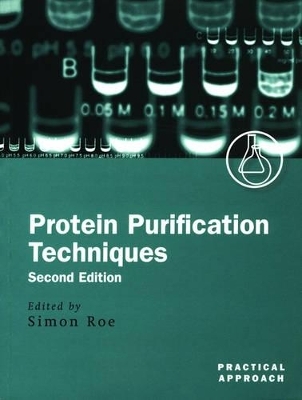
Protein Purification Techniques
A Practical Approach
Seiten
2001
|
2nd Revised edition
Oxford University Press (Verlag)
978-0-19-963673-0 (ISBN)
Oxford University Press (Verlag)
978-0-19-963673-0 (ISBN)
The protein purification Practical Approach books contain detailed practical information on the separation and purification of proteins. Protein Purification Techniques covers unit operations and analytical techniques in detail, while Protein Purification Applications has details of protein purification from a selected number of typical sources.
Proteins are an integral part of molecular and cellular structure and function and are probably the most purified type of biological molecule. In order to elucidate the structure and function of any protein it is first necessary to purify it. Protein purification techniques have evolved over the past ten years with improvements in equipment control, automation, and separation materials, and the introduction of new techniques such as affinity membranes and expanded beds. These developments have reduced the workload involved in protein purification, but there is still a need to consider how unit operations linked together to form a purification strategy, which can be scaled up if necessary. The two Practical Approach books on protein purification have therefore been thoroughly updated and rewritten where necessary. The core of both books is the provision of detailed practical guidelines aimed particularly at laboratory scale purification. Information on scale-up considerations is given where appropriate. The books are not comprehensive but do cover the major laboratory techniques and common sources of protein. Protein Purification Techniques focuses on unit operations and analytical techniques. It starts with an overview of purification strategy and then covers initial extraction and clarification techniques. The rest of the book concentrates on different purification methods with the emphasis being on chromatography. The final chapter considers general scale-up considerations. Protein Purification Applications describes purification strategies from common sources: mammalian cell culture, microbial cell culture, milk, animal tissue, and plant tissue. It also includes chapters on purification of inclusion bodies, fusion proteins, and purification for crystallography. A purification strategy that can produce a highly pure single protein from a crude mixture of proteins, carbohydrates, lipids, and cell debris to is a work of art to be admired. These books (available individually or as a set)are designed to give the laboratory worker the information needed to undertake the challenge of designing such a strategy.
Proteins are an integral part of molecular and cellular structure and function and are probably the most purified type of biological molecule. In order to elucidate the structure and function of any protein it is first necessary to purify it. Protein purification techniques have evolved over the past ten years with improvements in equipment control, automation, and separation materials, and the introduction of new techniques such as affinity membranes and expanded beds. These developments have reduced the workload involved in protein purification, but there is still a need to consider how unit operations linked together to form a purification strategy, which can be scaled up if necessary. The two Practical Approach books on protein purification have therefore been thoroughly updated and rewritten where necessary. The core of both books is the provision of detailed practical guidelines aimed particularly at laboratory scale purification. Information on scale-up considerations is given where appropriate. The books are not comprehensive but do cover the major laboratory techniques and common sources of protein. Protein Purification Techniques focuses on unit operations and analytical techniques. It starts with an overview of purification strategy and then covers initial extraction and clarification techniques. The rest of the book concentrates on different purification methods with the emphasis being on chromatography. The final chapter considers general scale-up considerations. Protein Purification Applications describes purification strategies from common sources: mammalian cell culture, microbial cell culture, milk, animal tissue, and plant tissue. It also includes chapters on purification of inclusion bodies, fusion proteins, and purification for crystallography. A purification strategy that can produce a highly pure single protein from a crude mixture of proteins, carbohydrates, lipids, and cell debris to is a work of art to be admired. These books (available individually or as a set)are designed to give the laboratory worker the information needed to undertake the challenge of designing such a strategy.
Purification strategy ; Getting started ; Analysis of purity ; Clarification techniques ; Cell disintegration and extraction techniques ; Concentration of the extract ; Separation on the basis of chemistry ; Chromatography on the basis of size ; Purification by exploitation of activity ; Scale up
| Erscheint lt. Verlag | 25.1.2001 |
|---|---|
| Reihe/Serie | Practical Approach Series ; 244 |
| Zusatzinfo | numerous tables and line figures |
| Verlagsort | Oxford |
| Sprache | englisch |
| Maße | 188 x 246 mm |
| Gewicht | 524 g |
| Themenwelt | Naturwissenschaften ► Biologie ► Biochemie |
| Naturwissenschaften ► Biologie ► Genetik / Molekularbiologie | |
| Naturwissenschaften ► Biologie ► Zellbiologie | |
| Naturwissenschaften ► Chemie ► Analytische Chemie | |
| Naturwissenschaften ► Chemie ► Organische Chemie | |
| Technik ► Umwelttechnik / Biotechnologie | |
| ISBN-10 | 0-19-963673-7 / 0199636737 |
| ISBN-13 | 978-0-19-963673-0 / 9780199636730 |
| Zustand | Neuware |
| Haben Sie eine Frage zum Produkt? |
Mehr entdecken
aus dem Bereich
aus dem Bereich


